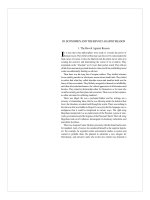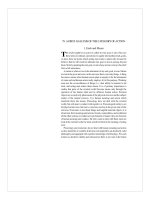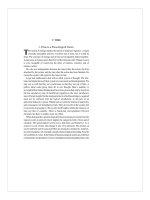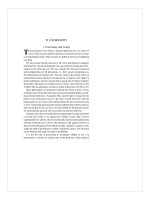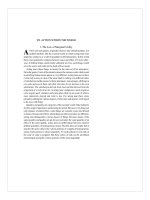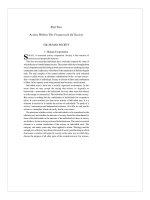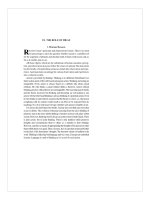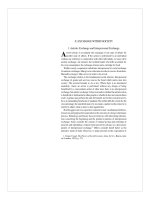Luận án kinh tế - "Human and action" - Chapter 12 potx
Bạn đang xem bản rút gọn của tài liệu. Xem và tải ngay bản đầy đủ của tài liệu tại đây (58.04 KB, 17 trang )
XII. THE SPHERE OF ECONOMIC CALCULATION
1. The Character of Monetary Entries
E
CONOMIC calculation can comprehend everything that is exchanged
against money.
The prices of goods and services are either historical data describing past
events or anticipations of probable future events. Information about a past price
conveys the knowledge that one or several acts of interpersonal exchange were
effected according to this ratio. It does not convey directly any knowledge about
future prices. We may often assume that the market conditions which deter-
mined the formation of prices in the recent past will not change at all or at least
not change considerably in the immediate future so that prices too will remain
unchanged or change only slightly. Such expectations are reasonable if the
prices concerned were the result of the interaction of many people ready to buy
or to sell provided the exchange ratios seemed propitious to them and if the
market situation was not influenced by conditions which are considered as
accidental, extraordinary, and not likely to return. However, the main task of
economic calculation is not to deal with the problems of unchanging or only
slightly changing market situations and prices, but to deal with change. The
acting individual either anticipates changes which will occur without his own
interference and wants to adjust his actions to this anticipated state of affairs; or
he wants to embark upon a project which will change conditions even if no other
factors produce a change. The prices of the past are for him merely starting
points in his endeavors to anticipate future prices.
Historians and statisticians content themselves with prices of the past.
Practical man looks at the prices of the future, be it only the immediate future
of the next hour, day, or month. For him the prices of the past are merely a help
in anticipating future prices. Not only in his preliminary calculation of the
expected outcome of planned action, but no less in his attempts to establish the
result of his past transactions, he is primarily concerned with future prices.
In balance sheets and in profit-and-loss statements the result of past action
becomes visible as the difference between the money equivalent of funds
owned (total assets minus total liabilities) at the beginning and at the end of
the period reported, and as the difference between the money equivalent of
costs incurred and gross proceeds earned. In such statements it is necessary
to enter the estimated money equivalent of all assets and liabilities other than
cash. These items should be appraised according to the prices at which they
could probably be sold in the future or, as is especially the case with
equipment for production processes, in reference to the prices to be expected
in the sale of merchandise manufactured with their aid. However, old
business customs and the provisions of commercial law and of the tax laws
have brought about a deviation from sound principles of accounting which
aim merely at the best attainable degree of correctness. These customs and
laws are not so much concerned with correctness in balance sheets and
profit-and-loss statements as with the pursuit of other aims. Commercial
legislation aims at a method of accounting which could indirectly protect
creditors against loss. It tends more or less to an appraisal of assets below
their estimated market value in order to make the net profit and the total
funds owned appear smaller than they really are. Thus a safety margin is
created which reduces the danger that, to the prejudice of creditors, too much
might be withdrawn from the firm as alleged profit and that an already
insolvent firm might go on until it had exhausted the means available for the
satisfaction of its creditors. Contrariwise tax laws often tend toward a
method of computation which makes earnings appear higher than an unbi-
ased method would. The idea is to raise effective tax rates without making
this raise visible in the nominal tax rates schedules. We must therefore
distinguish between economic calculation as it is practiced by businessmen
planning future transactions and those computations of business facts which
serve other purposes. The determination of taxes due and economic calcu-
lation are two different things. If a law imposing a tax upon the keeping of
domestic servants prescribes that one male servant should be counted as two
female servants, nobody would interpret such a provision as anything other
than a method for determining the amount of tax due. Likewise if an
inheritance tax law prescribes that securities should be appraised at the stock
market quotation on the day of the decedent’s death, we are merely provided
with a way of determining the amount of the tax.
The duly kept accounts in a system of correct bookkeeping are accurate
as to dollars and cents. They display an impressive precision, and the
numerical exactitude of their items seems to remove all doubts. In fact, the
most important figures they contain are speculative anticipations of future
THE SPHERE OF ECONOMIC CALCULATION 213
market constellations. It is a mistake to compare the items of any commercial
account to the items used in purely technological reckoning, e.g., in the
design for the construction of a machine. The engineer—as far as he attends
to the technological side of his job—applies only numerical relations estab-
lished by the methods of the experimental natural sciences; the businessman
cannot avoid numerical terms which are the outcome of his understanding
of future human conduct. The main thing in balance sheets and in profit-
and-loss statements is the evaluation of assets and liabilities not embodied
in cash. All such balances and statements are virtually interim balances and
interim statements. They describe as well as possible the state of affairs at
an arbitrarily chosen instant while life and action go on and do not stop. It
is possible to wind up individual business units, but the whole system of
social production never ceases. Nor are the assets and liabilities consisting
in cash exempt from the indeterminacy inherent in all business accounting
items. They depend on the future constellation of the market no less than
any item of inventory or equipment. The numerical exactitude of business
accounts and calculations must not prevent us from realizing the uncertainty
and speculative character of their items and of all computations based on
them.
Yet, these facts do not detract from the efficiency of economic calcula-
tion. Economic calculation is as efficient as it can be. No reform could add
to its efficiency. It renders to acting man all the services which he can obtain
from numerical computation. It is, of course, not a means of knowing future
conditions with certainty, and it does not deprive action of its speculative
character. But this can be considered a deficiency only by those who do not
come to recognize the facts that life is not rigid, that all things are perpetually
fluctuating, and that men have no certain knowledge about the future.
It is not the task of economic calculation to expand man’s information
about future conditions. Its task is to adjust his actions as well as possible to
his present opinion concerning want-satisfaction in the future. For this
purpose acting man needs a method of computation, and computation
requires a common denominator to which all items entered are to be
referable. The common denominator of economic calculation is money.
2. The Limits of Economic Calculation
Economic calculation cannot comprehend things which are not sold and
bought against money.
214 HUMAN ACTION
There are things which are not for sale and for whose acquisition
sacrifices other than money and money’s worth must be expended. He who
wants to train himself for great achievements must employ many means,
some of which may require expenditure of money. But the essential things
to be devoted to such an endeavor are not purchasable. Honor, virtue, glory,
and likewise vigor, health, and life itself play a role in action both as means
and as ends, but they do not enter into economic calculation.
There are things which cannot at all be evaluated in money, and there are
other things which can be appraised in money only with regard to a fraction
of the value assigned to them. The appraisal of an old building must disregard
its artistic and historical eminence as far as these qualities are not a source
of proceeds in money or goods vendible. What touches a man’s heart only
and does not induce other people to make sacrifices for its attainment
remains outside the pale of economic calculation.
However, all this does not in the least impair the usefulness of economic
calculation. Those things which do not enter into the items of accountancy
and calculation are either ends or goods of the first order. No calculation is
required to acknowledge them fully and to make due allowance for them.
All that acting man needs in order to make his choice is to contrast them
with the total amount of costs their acquisition or preservation requires. Let
us assume that a town council has to decide between two water supply
projects. One of them implies the demolition of a historical landmark, while
the other at the cost of an increase in money expenditure spares this
landmark. The fact that the feelings which recommend the conservation of
the monument cannot be estimated in a sum of money does not in any way
impede the councilmen’s decision. The values that are not reflected in any
monetary exchange ratio are, on the contrary, by this very fact lifted into a
particular position which makes the decision rather easier. No complaint is
less justified than the lamentation that the computation methods of the
market do not comprehend things not vendible. Moral and aesthetic values
do not suffer any damage on account of this fact.
Money, money prices, market transactions, and economic calculation
based upon them are the main targets of criticism. Loquacious sermonizers
disparage Western civilization as a mean system of mongering and peddling.
Complacency, self-righteousness, and hypocrisy exult in scorning the “dol-
lar-philosophy” of our age. Neurotic reformers, mentally unbalanced literati,
and ambitious demagogues take pleasure in indicting “rationality” and in
preaching the gospel of the “irrational.” In the eyes of these babblers money
THE SPHERE OF ECONOMIC CALCULATION 215
and calculation are the source of the most serious evils. However, the fact
that men have developed a method of ascertaining as far as possible the
expediency of their actions and of removing uneasiness in the most practical
and economic way does not prevent anybody from arranging his conduct
according to the principle he considers to be right. The “materialism” of the
stock exchange and of business accountancy does not hinder anybody from
living up to the standards of Thomas a Kempis or from dying for a noble
cause. The fact that the masses prefer detective stories to poetry and that it
therefore pays better to write the former than the latter, is not caused by the
use of money and monetary accounting. It is not the fault of money that there
are gangsters, thieves, murderers, prostitutes, corruptible officials and
judges. It is not true that honesty does not “pay.” It pays for those who prefer
fidelity to what they consider to be right to the advantages which they could
derive from a different attitude.
Other critics of economic calculation fail to realize that it is a method
available only to people acting in the economic system of the division of
labor in a social order based upon private ownership of the means of
production. It can only serve the considerations of individuals or groups of
individuals operating in the institutional setting of this social order. It is
consequently a calculation of private profits and not of “social welfare.” This
means that the prices of the market are the ultimate fact for economic
calculation. It cannot be applied for considerations whose standard is not the
demand of the consumers as manifested on the market but the hypothetical
valuations of a dictatorial body managing all national or earthly affairs. He
who seeks to judge actions from the point of view of a pretended “social
value,” i.e., from the point of view of the “whole society,” and to criticize
them by comparison with the events in an imaginary socialist system in
which his own will is supreme, has no use for economic calculation.
Economic calculation in terms of money prices is the calculation of entre-
preneurs producing for the consumers of a market society. It is of no avail
for other tasks.
He who wants to employ economic calculation must not look at affairs
in the manner of a despotic mind. Prices can be used for calculation by the
entrepreneurs, capitalists, landowners, and wage earners of a capitalist
society. For matters beyond the pursuits of these categories it is inadequate.
It is nonsensical to evaluate in money objects which are not negotiated on
the market and to employ in calculations arbitrary items which do not refer
to reality. The law determines the amount which ought to be paid as
216 HUMAN ACTION
indemnification for having caused a man’s death. But the statute enacted for
the determination of the amends due does not mean that there is a price for
human life. Where there is slavery, there are market prices of slaves. Where
there is no slavery man, human life, and health are res extra commercium.
In a society of free men the preservation of life and health are ends, not
means. They do not enter into any process of accounting means.
It is possible to determine in terms of money prices the sum of the income
or the wealth of a number of people. But it is nonsensical to reckon national
income or national wealth. As soon as we embark upon considerations
foreign to the reasoning of a man operating within the pale of a market
society, we are no longer helped by monetary calculation methods. The
attempts to determine in money the wealth of a nation or of the whole of
mankind are as childish as the mystic efforts to solve the riddles of the
universe by worrying about the dimensions of the pyramid of Cheops. If a
business calculation values a supply of potatoes at $100, the idea is that it
will be possible to sell it or to replace it against this sum. If a whole
entrepreneurial unit is estimated $1,000,000, it means that one expects to
sell it for this amount. But what is the meaning of the items in a statement
of a nation’s total wealth? What is the meaning of the computation’s final
result? What must be entered into it and what is to be left outside? Is it correct
or not to enclose the “value” of the country’s climate and the people’s innate
abilities and acquired skill? The businessman can convert his property into
money, but a nation cannot.
The money equivalents as used in acting and in economic calculation are
money prices, i.e., exchange ratios between money and other goods and
services. The prices are not measured in money; they consist in money.
Prices are either prices of the past or expected prices of the future. A price
is necessarily a historical fact either of the past or of the future. There is
nothing in prices which permits one to liken them to the measurement of
physical and chemical phenomena.
3. The Changeability of Prices
Exchange ratios are subject to perpetual change because the conditions which
produce them are perpetually changing. The value that an individual attaches
both to money and to various goods and services is the outcome of a moment’s
choice. Every later instant may generate something new and bring about other
considerations and valuations. Not that prices are fluctuating, but that they do
not alter more quickly could fairly be deemed a problem requiring explanation.
THE SPHERE OF ECONOMIC CALCULATION 217
Daily experience teaches people that the exchange ratios of the market
are mutable. One would assume that their ideas about prices would take full
account of this fact. Nevertheless all popular notions of production and
consumption, marketing and prices are more or less contaminated by a vague
and contradictory notion of price rigidity. The layman is prone to consider
the preservation of yesterday’s price structure both as normal and fair, and
to condemn changes in the exchange ratios as a violation of the rules of
nature and of justice.
It would be a mistake to explain these popular beliefs as a precipitate of
old opinions conceived in earlier ages of more stable conditions of produc-
tion and marketing. It is questionable whether or not prices were less
changeable in those older days. On the contrary, it could rather be asserted
that the merger of local markets into larger national markets, the final
emergence of a world embracing world market, and the evolution of com-
merce aiming at continuously supplying the consumers have made price
changes less frequent and less sharp. In precapitalistic times their was more
stability in technological methods of production, but there was much more
irregularity in supplying the various local markets and in adjusting supply
to their changing demands. But even if it were true that prices were
somewhat more stable in a remote past, it would be of little avail for our age.
The popular notions about money and money prices are not derived from ideas
formed in the past. It would be wrong to interpret them as atavistic remnants.
Under modern conditions every individual is daily faced with so many problems
of buying and selling that we are right in assuming that his thinking about these
matters is not simply a thoughtless reception of traditional ideas.
It is easy to understand why those whose short-run interests are hurt by
a change in prices resent such changes, emphasize that the previous prices
were not only fairer but also more normal, and maintain that price stability is in
conformity with the laws of nature and of morality. But every change in prices
furthers the short-run interests of other people. Those favored will certainly not
be prompted by the urge to stress the fairness and normalcy of price rigidity.
Neither atavistic reminiscences nor the state of selfish group interests can
explain the popularity of the idea of price stability. Its roots are to be seen
in the fact that notions concerning social relations have been constructed
according to the pattern of the natural sciences. The economists and sociol-
ogists who aimed at shaping the social sciences according to the pattern of
physics or physiology only indulged in a way of thinking which popular
fallacies had adopted long before.
218 HUMAN ACTION
Even the classical economists were slow to free themselves from this error.
With them value was something objective, i.e., a phenomenon of the external
world and a quality inherent in things and therefore measurable. They utterly
failed to comprehend the purely human and voluntaristic character of value
judgments. As far as we can see today, it was Samuel Bailey who first disclosed
what is going on in preferring one thing to another.
1
But his book was overlooked
as were the writings of other precursors of the subjective theory of value.
It is not only a task of economic science to discard the errors concerning
measurability in the field of action. It is no less a task of economic policy.
For the failures of present-day economic policies are to some extent due to
the lamentable confusion brought about by the idea that there is something
fixed and therefore measurable in interhuman relations.
4. Stabilization
An outgrowth of all these errors is the idea of stabilization.
Shortcomings in the governments’ handling of monetary matters and the
disastrous consequences of policies aimed at lowering the rate of interest and at
encouraging business activities through credit expansion gave birth to the ideas
which finally generated the slogan “stabilization.” One can explain its emergence
and its popular appeal, one can understand it as the fruit of the last hundred and
fifty years’ history of currency and banking, one can, as it were, plead extenuating
circumstances for the error involved. But no such sympathetic appreciation can
render its fallacies any more tenable.
Stability, the establishment of which the program of stabilization aims at, is an
empty and contradictory notion. The urge toward action, i.e., improvement of the
conditions of life, is inborn in man. Man himself changes from moment to moment
and his valuations, volitions, and acts change with him. In the realm of action there
is nothing perpetual but change. There is no fixed point in this ceaseless fluctuation
other than the eternal aprioristic categories of action. It is vain to sever valuation
and action from man’s unsteadiness and the changeability of his conduct and to
argue as if there were in the universe eternal values independent of human value
judgments and suitable to serve as a yardstick for the appraisal of real action.
2
THE SPHERE OF ECONOMIC CALCULATION 219
1. Cf. Samuel Bailey, A Critical Dissertation on the Nature, Measures and
Causes of Values. London, 1825. No.7 in Series of Reprints of Scarce Tracts in
Economics and Political Science, London School of Economics (London,
1931).
2. For the propensity of the mind to view rigidity and unchangeability as the
essential thing and change and motion as the accidental, cf. Bergson, La Pensee
et le mouvant, pp. 85 ff.
All methods suggested for a measurement of the changes in the monetary
unit’s purchasing power are more or less unwittingly founded on the illusory
image of an eternal and immutable being who determines by the application
of an immutable standard the quantity of satisfaction which a unit of money
conveys to him. It is a poor justification of this ill-thought idea that what is
wanted is merely to measure changes in the purchasing power of money.
The crux of the stability notion lies precisely in this concept of purchasing
power. The layman, laboring under the ideas of physics, once considered
money as a yardstick of prices. He believed that fluctuations of exchange
ratios occur only in the relations between the various commodities and
services and not also in the relation between money and the “totality” of
goods and services. Later, people reversed the argument. It was no longer
money to which constancy of value was attributed, but the “totality” of
things vendible and purchasable. People began to devise methods for work-
ing up complexes of commodity units to be contrasted to the monetary unit.
Eagerness to find indexes for the measurement of purchasing power silenced
all scruples. Both the doubtfulness and the incomparability of the price
records employed and the arbitrary character of the procedures used for the
computation of averages were disregarded.
Irving Fisher, the eminent economist, who was the champion of the
American stabilization movement, contrasts with the dollar a basket con-
taining all the goods the housewife buys on the market for the current
provision of her household. In the proportion in which the amount of money
required for the purchase of the content of this basket changes, the purchas-
ing power of the dollar has changed. The goal assigned to the policy of
stabilization is the preservation of the immutability of this money expendi-
ture.
3
This would be all right if the housewife and her imaginary basket were
constant elements, if the basket were always to contain the same goods and
the same quantity of each and if the role which this assortment of goods
plays in the family’s life were not to change. But we are living in a world in
which none of these conditions is realized.
First of all there is the fact that the quality of the commodities produced
and consumed changes continuously. It is a mistake to identify wheat with
wheat, not to speak of shoes, hats, and other manufactures. The great price
differences in the synchronous sales of commodities which mundane speech
and statistics arrange in the same class clearly evidence this truism. An idiomatic
expression asserts that two peas are alike; but buyers and sellers distinguish
220 HUMAN ACTION
3. Cf. Irving Fisher, The Monetary Illusion (New York, 1928), pp. 19-20.
various qualities and grades of peas. A comparison of prices paid at different
places or at different dates for commodities which technology or statistics
calls by the same name, is useless if it is not certain that their qualities—but
for the place difference—are perfectly the same. Quality means in this
connection: all those properties to which the buyers and would-be-buyers
pay heed. The mere fact that the quality of all goods and services of the first
order is subject to change explodes one of the fundamental assumptions of
all index number methods. It is irrelevant that a limited amount of goods of
the higher orders—especially metals and chemicals which can be uniquely
determined by a formula—are liable to a precise description of their char-
acteristic features. A measurement of purchasing power would have to rely
upon the prices of the goods and services of the first order and, what is more,
of all of them. To employ the prices of the producers’ goods is not helpful
because it could not avoid counting the various stages of the production of
one and the same consumers’ good several times and thus falsifying the
result. A restriction to a group of selected goods would be quite arbitrary
and therefore vicious.
But even apart from all these insurmountable obstacles the task would
remain insoluble. For not only do the technological features of commodities
change and new kinds of goods appear while many old ones disappear.
Valuations change too, and they cause changes in demand and production.
The assumptions of the measurement doctrine would require men whose
wants and valuations are rigid. Only if people were to value the same things
always in the same way, could we consider price changes as expressive of
changes in the power of money to buy things.
As it is impossible to establish the total amount of money spent at a given
fraction of time for consumers’ goods, statisticians must rely upon the prices
paid for individual commodities. This raises two further problems for which
there is no apodictic solution. It becomes necessary to attach to the various
commodities coefficients of importance. It would be manifestly wrong to let
the prices of various commodities enter into the computation without taking
into account the different roles they play in the total system of the
individuals’ households. But the establishment of such proper weighting is
again arbitrary. Secondly, it becomes necessary to compute averages out of
the data collected and adjusted. But there exist different methods for the
computation of averages. There are the arithmetic, the geometric, the har-
monic averages, there is the quasi-average known as the median. Each of
them leads to different results. None of them can be recognized as the unique
THE SPHERE OF ECONOMIC CALCULATION 221
way to attain a logically unassailable answer. The decision in favor of one
of these methods of computation is arbitrary.
If all human conditions were unchangeable, if all people were always to
repeat the same actions because their uneasiness and their ideas about its
removal were constant, or if we were in a position to assume that changes
in these factors occurring with some individuals or groups are always
outweighed by opposite changes with other individuals or groups and
therefore do not effect total demand and total supply, we would live in a
world of stability. But the idea that in such a world money’s purchasing
power could change is contradictory. As will be shown later, changes in the
purchasing power of money must necessarily affect the prices of different
commodities and services at different times and to different extents; they
must consequently bring about changes in demand and supply, in production
and consumption.
4
The idea implied in the inappropriate term level of prices,
as if —other things being equal—all prices could rise or drop evenly, is
untenable. Other things cannot remain equal if the purchasing power of
money changes.
In the field of praxeology and economics no sense can be given to the
notion of measurement. In the hypothetical state of rigid conditions there
are no changes to be measured. In the actual world of change there are no
fixed points, dimensions, or relations which could serve as a standard. The
monetary unit’s purchasing power never changes evenly with regard to all
things vendible and purchasable. The notions of stability and stabilization
are empty if they do not refer to a state of rigidity and its preservation.
However, this state of rigidity cannot even be thought out consistently to its
ultimate logical consequences; still less can it be realized.
5
Where there is
action, there is change. Action is a lever of change.
The pretentious solemnity which statisticians and statistical bureaus
display in computing indexes of purchasing power and cost of living is out
of place. These index numbers are at best rather crude and inaccurate
illustrations of changes which have occurred. In periods of slow alterations
in the relation between the supply of and the demand for money they do not
convey any information at all. In periods of inflation and consequently of
sharp price changes they provide a rough image of events which every
individual experiences in his daily life. A judicious housewife knows much
more about price changes as far as they affect her own household than the
222 HUMAN ACTION
4. See below, pp. 411-413.
5. [5]. See below, pp. 247-250.
statistical averages can tell. She has little use for computations disregarding
changes both in quality and in the amount of goods which she is able or
permitted to buy at the prices entering into the computation. If she “mea-
sures” the changes for her personal appreciation by taking the prices of only
two or three commodities as a yardstick, she is no less “scientific” and no
more arbitrary than the sophisticated mathematicians in choosing their
methods for the manipulation of the data of the market.
In practical life nobody lets himself be fooled by index numbers. Nobody
agrees with the fiction that they are to be considered as measurements.
Where quantities are measured, all further doubts and disagreements con-
cerning their dimensions cease. These questions are settled. Nobody ven-
tures to argue with the meteorologists about their measurements of temper-
ature, humidity, atmospheric pressure, and other meteorological data. But
on the other hand nobody acquiesces in an index number if he does not
expect a personal advantage from its acknowledgment by public opinion.
The establishment of index numbers does not settle disputes; it merely shifts
them into a field in which the clash of antagonistic opinions and interests is
irreconcilable.
Human action originates change. As far as there is human action there is
no stability, but ceaseless alteration. The historical process is a sequence of
changes. It is beyond the power of man to stop it and to bring about an age
of stability in which all history comes to a standstill. It is man’s nature to
strive after improvement, to beget new ideas, and to rearrange the conditions
of his life according to these ideas.
The prices of the market are historical facts expressive of a state of affairs
that prevailed at a definite instant of the irreversible historical process. In
the praxeological orbit the concept of measurement does not make any sense.
In the imaginary—and, of course, unrealizable—state of rigidity and stabil-
ity there are no changes to be measured. In the actual world of permanent
change there are no fixed points, objects, qualities or relations with regard
to which changes could be measured.
5. The Root of the Stabilization Idea
Economic calculation does not require monetary stability in the sense in
which this term is used by the champions of the stabilization movement. The
fact that rigidity in the monetary unit’s purchasing power is unthinkable and
unrealizable does not impair the methods of economic calculation. What
THE SPHERE OF ECONOMIC CALCULATION 223
economic calcualtion requires is a monetary system whose functioning is
not sabotaged by government interference. The endeavors to expand the
quantity of money in circulation either in order to increase the government’s
capacity to spend or in order to bring about a temporary lowering of the rate
of interest disintegrate all currency matters and derange economic calcula-
tion. The first aim of monetary policy must be to prevent governments from
embarking upon inflation and from creating conditions which encourage
credit expansion on the part of banks. But this program is very different from
the confused and self-contradictory program of stabilizing purchasing
power.
For the sake of economic calculation all that is needed is to avoid great
and abrupt fluctuations in the supply of money. Gold and, up to the middle
of the nineteenth century, silver served very well all the purposes of
economic calculation. Changes in the relation between the supply of and the
demand for the precious metals and the resulting alterations in purchasing
power went on so slowly that the entrepreneur’s economic calculation could
disregard them without going too far afield. Precision is unattainable in
economic calculation quite apart from the shortcomings emanating from not
paying due consideration to monetary changes.
6
The planning businessman
cannot help employing data concerning the unknown future; he deals with
future prices and future costs of production. Accounting and bookkeeping
in their endeavors to establish the result of past action are in the same
position as far as they rely upon the estimation of fixed equipment, inven-
tories, and receivables. In spite of all these uncertainties economic calcula-
tion can achieve its tasks. For these uncertainties do not stem from deficien-
cies of the system of calculation. They are inherent in the essence of acting
that always deals with the uncertain future.
The idea of rendering purchasing power stable did not originate from
endeavors to make economic calculation more correct. Its source is the wish
to create a sphere withdrawn from the ceaseless flux of human affairs, a
realm which the historical process does not effect. Endowments which were
designed to provide in perpetuity for an ecclesiastic body, for a charitable
institution, or for a family were long established in land or in disbursement
224 HUMAN ACTION
6. No practical calculation can ever be precise. The formula underlying the
process of calculation may be exact; the calculation itself depends on the
approximate establishment of quantities and is therefore necessarily inaccurate.
Economics is, as has been shown above (p. 39), an exact science of real things.
But as soon as price data are introduced into the chain of thought, exactitude is
abandoned and economic history is submitted for economic theory.
of agricultural products in kind. Later annuities to be settled in money were
added. Endowers and beneficiaries expected that an annuity determined in
terms of a definite amount of precious metals would not be affected by
changes in economic conditions. But these hopes were illusory. Later
generations learned that the plans of their ancestors were not realized.
Stimulated by this experience they began to investigate how the aims sought
could be attained. Thus they embarked upon attempts to measure changes
in purchasing power and to eliminate such changes.
The problem assumed much greater importance when governments
initiated their policies of long-term irredeemable and perpetual loans.
The state, this new deity of the dawning age of statolatry, this eternal and
superhuman institution beyond the reach of earthly frailties, offered to
the citizen an opportunity to put his wealth in safety and to enjoy a stable
income secure against all vicissitudes. It opened a way to free the
individual from the necessity of risking and acquiring his wealth and his
income anew each day in the capitalist market. He who invested his funds
in bonds issued by the government and its subdivisions was no longer
subject to the inescapable laws of the market and to the sovereignty of
the consumers. He was no longer under the necessity of investing his
funds in such a way that they would best serve the wants and needs of
the consumers. He was secure, he was safeguarded against the dangers
of the competitive market in which losses are the penalty of inefficiency;
the eternal state had taken him under its wing and guaranteed him the
undisturbed enjoyment of his funds. Henceforth his income no longer
stemmed from the process of supplying the wants of the consumers in
the best possible way, but from the taxes levied by the state’s apparatus
of compulsion and coercion. He was no longer a servant of his fellow
citizens, subject to their sovereignty; he was a partner of the government
which ruled the people and exacted tribute from them. What the govern-
ment paid as interest was less than the market offered. But this difference
was far outweighed by the unquestionable solvency of the debtor, the
state whose revenue did not depend on satisfying the public, but on
insisting on the payment of taxes.
In spite of the unpleasant experiences with public debts in earlier days,
people were ready to trust freely the modernized state of the nineteenth
century. It was generally assumed that this new state would scrupulously
meet its voluntarily contracted obligations. Capitalists and entrepreneurs
were fully aware of the fact that in the market society there is no means of
THE SPHERE OF ECONOMIC CALCULATION 225
preserving acquired wealth other than by acquiring it anew each day in
tough competition with everybody, with the already existing firms as
well as with newcomers “operating on a shoe string.” The entrepreneur,
grown old and weary and no longer prepared to risk his hard-earned
wealth by new attempts to meet the wants of consumers, and the heir of
other people’s profits, lazy and fully conscious of his own inefficiency,
preferred investment in bonds of the public debt because they wanted to
be free from the law of the market.
Now, the irredeemable perpetual public debt presupposes the stability
of purchasing power. Although the state and its compulsion may be
eternal, the interest paid on the public debt could be eternal only if based
on a standard of unchanging value. In this form the investor who for
security’s sake shuns the market, entrepreneurship, and investment in
free enterprise and prefers government bonds is faced again with the
problem of the changeability of all human affairs. He discovers that in
the frame of a market society there is no room left for wealth not
dependent upon the market. His endeavors to find an inexhaustible
source of income fail.
There are in this world no such things as stability and security and no
human endeavors are powerful enough to bring them about. There is in
the social system of the market society no other means of acquiring
wealth and of preserving it than successful service to the consumers. The
state is, of course, in a position to exact payments from its subjects and
to borrow funds. However, even the most ruthless government in the long
run is not able to defy the laws determining human life and action. If the
government uses the sums borrowed for investment in those lines in
which they best serve the wants of the consumers, and if it succeeds in
these entrepreneurial activities in free and equal competition with all
private entrepreneurs, it is in the same position as any other businessman;
it can pay interest because it has made surpluses. But if the government
invests funds unsuccessfully and no surplus results, or if it spends the
money for current expenditure , the capital borrowed shrinks or
disappears entirely, and no source is opened from which interest and
principal could be paid. Then taxing the people is the only method
available for complying with the articles of the credit contract. In
asking taxes for such payments the government makes the citizens
answerable for money squandered in the past. The taxes paid are not
compensated by any present service rendered by the government’s
226 HUMAN ACTION
apparatus. The government pays interest on capital which has been
consumed and no longer exists. The treasury is burdened with the
unfortunate results of past policies.
A good case can be made out for short-term government debts under
special conditions. Of course, the popular justification of war loans is
nonsensical. All the materials needed for the conduct of a war must be
provided by restriction of civilian consumption, by using up a part of the
capital available and by working harder. The whole burden of warring falls
upon the living generation. The coming generations are only affected to the
extent to which, on account of the war expenditure, they will inherit less
from those now living than they would have if no war had been fought.
Financing a war through loans does not shift the burden to the sons and
grandsons.
7
It is merely a method of distributing the burden among the
citizens. If the whole expenditure had to be provided by taxes, only those
who have liquid funds could be approached. The rest of the people would
not contribute adequately. Short-term loans can be instrumental in removing
such inequalities, as they allow for a fair assessment on the owners of fixed
capital.
The long-term public and semipublic credit is a foreign and disturbing
element in the structure of a market society. Its establishment was a futile
attempt to go beyond the limits of human action and to create an orbit of
security and eternity removed from the transitoriness and instability of
earthly affairs. What an arrogant presumption to borrow and to lend
money for ever and ever, to make contracts for eternity, to stipulate for
all times to come! In this respect it mattered little whether the loans were
in a formal manner made irredeemable or not; intentionally and practi-
cally they were as a rule considered and dealt with as such. In the heyday
of liberalism some Western nations really retired parts of their long-term
debt by honest reimbursement. But for the most part new debts were only
heaped upon old ones. The financial history of the last century shows a
steady increase in the amount of public indebtedness. Nobody believes
that the states will eternally drag the burden of these interest payments.
It is obvious that sooner or later all these debts will be liquidated in some
way or other, but certainly not by payment of interest and principal
according to the terms of the contract. A host of sophisticated writers are
THE SPHERE OF ECONOMIC CALCULATION 227
7. Loans, in this context, mean funds borrowed from those who have money
available for lending. We do not refer here to credit expansion of which the main
vehicle in present-day America is borrowing from the commercial banks.
already busy elaborating the moral palliation for the day of final settlement.
8
The fact that economic calculation in terms of money is unequal to the
tasks which are assigned to it in these illusory schemes for establishment of
an unrealizable realm of calm removed from the inescapable limitations of
human action and providing eternal security cannot be called a deficiency.
There are no such things as eternal, absolute, and unchanging values. The
search for a standard of such values is vain. Economic calculation is not
imperfect because it does not correspond to the confused ideas of people
yearning for a stable income not dependent on the productive processes of
men.
228 HUMAN ACTION
8. The most popular of these doctrines is crystallized in the phrase: A public
debt is no burden because we owe it to ourselves. If this were true, then the
wholesale obliteration of the public debt would be an innocuous operation, a
mere act of bookkeeping and accountancy. The fact is that the public debt
embodies claims of people who have in the past entrusted funds to the
government against all those who are daily producing new wealth. It burdens
the producing strata for the benefit of another part of the people. It is possible
to free the producers of new wealth from this burden by collecting the taxes
required for the payments exclusively from the bondholders. But this means
undisguised repudiation.


